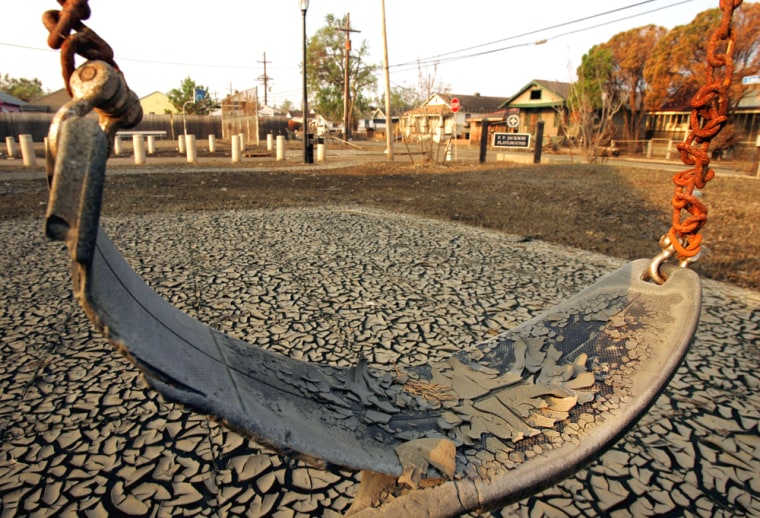Even after the latest hurricane crisis eases, and downtown businesses along with French Quarter topless bars reopen, life in New Orleans will be far from normal. Among the somber distinctions: For months to come this will be an almost childless city.
Dozens of schools were irreparably damaged by Hurricane Katrina, and only a handful are expected to open before January. Few day-care centers will be available for preschoolers, and health experts warn that children are at extra risk of contamination if they come back before the city is thoroughly cleaned of the foul floodwater's residue.
"It's a big concern of ours," said the Rev. William Maestri, superintendent of the city's Roman Catholic schools. "We want our families back."
Until they do return, a whole sector of the economy will be in limbo - not only child care workers and teachers, but also pediatricians, owners of child-oriented stores and others. Numerous New Orleans teachers, faced with payroll problems and no work in their home city, are getting hired elsewhere.
By the tens of thousands, New Orleans' children are scattered around the United States, enrolling in schools, making new friends or — in some cases — getting into fights with the local students. Many of their parents want to return home when conditions allow, but many others say they may settle in their new locations, almost certainly producing a significant drop in New Orleans' population of children.
‘We have bad schools’
Arthur Johnson, a lifetime New Orleans resident, said one of his adult daughters evacuated and placed her four children in Texas public schools, where they were faring better than in their hometown school.
"We have bad schools here," he said. "We've been knowing that for years."
But Michelle Bailey, a hospital worker who evacuated with her three children to Houston, said she wanted to bring her family back to New Orleans.
"My kids can't go to school now," she said. "Last week they went and a big fight broke out."
New Orleans officials hope to open a few schools Nov. 1 on the West Bank, a section of the city relatively unscathed by Katrina. But the school board president, Torin Sanders, said a broader reopening in the main part of the city probably wouldn't occur until January — and even that would involve only a limited number of the 126 public schools.
The plan, he indicated, would be to open certain schools that suffered little damage, accommodating returning students even if they lived in other neighborhoods.
Long-term benefit?
Sanders said the widely criticized school system, which served 60,000 students, could benefit in the long term.
"We are poised to take advantage of this, to make our schools the best in the country," he said, "Most of our buildings were built before World War II. This is an opportunity to make them environmentally sound, with new technology and better security, with more specialized programs in the high schools."
Sandra Adams, executive director of Louisiana Maternal Child and Health Coalition, said it was possible that the public schools wouldn't be fully operational until the fall of 2006.
"It's going to be a city without children for some months," she said. "Some people say the only way to fix the New Orleans school system is to start from scratch, and I think we're at scratch today."
The Catholic school system, under Maestri's direction, operates 22 schools in the city serving 20,000 children.
"We want to assess those schools, find out what the needs are and see how quickly we can open them," Maestri said. "We believe the schools are the magnets of hope, the institutions that draw families back."
Fears of health risks
Along with uncertainty about education, many parents are likely to wonder if their children face health risks upon returning to a city where the water supply was tainted and almost every neighborhood — including school yards and playgrounds — coated with bacteria-fouled floodwater.
"Kids are more susceptible to toxins, bacterial contamination," said Dr. Keith Perrin, president of the Louisiana chapter of the American Academy of Pediatrics. "They absorb things differently than adults. They're more prone to putting things into their mouths."
Any child returning in the near future should receive a tetanus shot, Perrin said, although he noted that local vaccine supplies had been depleted by heat damage when cooling units failed during the flood.
Local pediatricians are likely to lose many of their young patients, at least for the next few months, but Perrin predicted that most would do fine serving children from suburbs where schools are expected to reopen soon.
Police Detective K.M. Johnson said he hoped and expected that his grown children would return with his four grandchildren as soon as schools reopen.
"Nobody's running away," he said. "It's a little setback, that's all."
For some tourists, the idea of a child-free New Orleans might seem almost appropriate, given that visitors are lured by gambling, business conventions and the French Quarter's late-night drinking and naughtiness. Locals don't see their city that way.
"A lot of people think of Bourbon Street, Mardi Gras — things that are very adult-oriented," said Sanders, the school board president. "But New Orleans is a very family friendly place. People from here know that."
